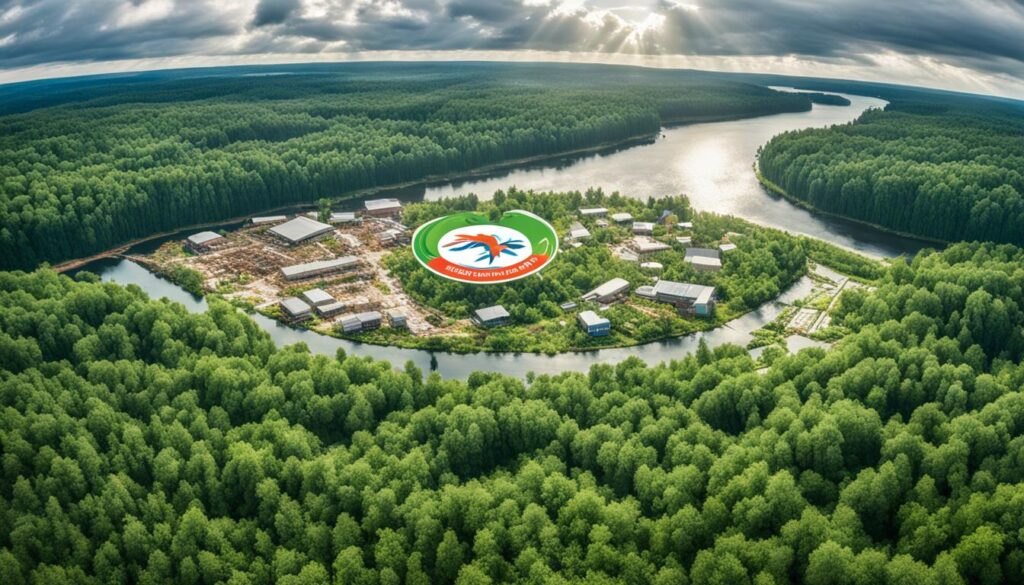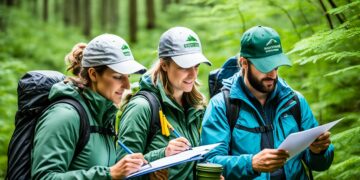Protecting our planet’s natural habitats is key to keeping the balance of nature conservation, habitat preservation, and environmental protection. We all have a role in using land management practices that are good for the planet. Supporting endangered species and ecotourism is also important. This guide will give you the knowledge and tools to help our natural world.
We will look at why biodiversity matters, the dangers to our natural habitats, and how to protect them. By using sustainable land management, we can save the ecosystem services our natural places offer. Let’s work together to protect our planet’s valuable resources for the future.
Understanding the Importance of Natural Habitats
Natural habitats are key to keeping our planet’s ecosystems in balance. They support a wide variety of life forms, from huge trees to tiny microorganisms. Each species is crucial for the health of our ecosystems.
Biodiversity and Ecosystem Services
Healthy natural habitats support diverse ecosystems. These ecosystems give us clean air, fresh water, fertile soil, and help control the climate. The more diverse a habitat is, the better it can handle threats like climate change and deforestation.
Threats to Natural Habitats
Natural habitats face many threats that harm their ability to support life. Deforestation, urban growth, and farming lead to habitat loss and biodiversity decline. Climate change also threatens these habitats by changing weather patterns.
Protecting natural habitats is vital for our planet and all living things. By understanding their value, we can work to reduce threats. This helps ensure a healthy future for our planet and all its life.
Sustainable Land Management Practices
Protecting natural habitats is key to our future. Sustainable land management offers a way to meet human needs without harming nature. Techniques like sustainable agriculture and forestry help us use our planet’s resources wisely.
Sustainable agriculture focuses on soil health and biodiversity. It uses methods like crop rotation and cover cropping to reduce harm to the environment. Sustainable forestry manages woodlands carefully, balancing logging with forest growth and wildlife protection.
Conserving land is crucial, and efforts like protected areas and restoring degraded lands help. Regenerative farming and agroforestry also play a big part. These methods improve soil and help store carbon, protecting biodiversity.
By using these sustainable practices, we can live in harmony with nature. Working together and using new solutions, we can save the natural habitats that support life on Earth.
Protecting Endangered Species and Their Habitats
With environmental challenges growing, protecting endangered species and their homes is now key for wildlife conservation. These animals face threats like habitat loss, poaching, and climate change. We must act fast and keep acting to help them survive and recover.
Conservation Efforts
Governments, non-profits, and people are leading conservation efforts to save endangered species and their habitats. Laws like the Endangered Species Act in the U.S. help protect wildlife. Programs like captive breeding and reintroduction help some endangered species.
Community-based conservation works well too. Local communities work with conservation groups to protect their ecosystems. This way, communities help protect endangered species and their homes.
Habitat Restoration Initiatives
Habitat restoration projects aim to fix and bring back damaged natural areas for endangered species. These projects plan and do work to bring back native plants, remove invaders, and fix the ecosystem balance. This helps endangered species to do well.
Restoring habitats helps endangered species and boosts the area’s biodiversity and ecosystem services. This approach to conservation gives endangered species the resources they need to come back strong in their natural homes.

Community Involvement in Nature Conservation
Protecting our natural habitats is not just up to governments and groups. It’s a job for local communities too. By joining conservation efforts, people can help keep ecosystems balanced and protect endangered species.
Volunteer Opportunities
Volunteering is a key way for people to help nature. There are many projects that need volunteers. You can help with cleanups, planting trees, monitoring wildlife, or restoring habitats.
Citizen science lets people collect data on local plants and animals. This helps scientists and groups understand ecosystems better. It also makes people appreciate nature more.
Getting involved in environmental activism is another way to make a difference. You can push for better land use, support endangered habitats, or spread the word about conservation. Together, communities can make their voices heard and push for policies that protect nature.
Local communities are key to nature conservation. By volunteering, doing citizen science, and fighting for the environment, people can really help protect nature. This approach not only helps the environment but also builds a stronger connection to nature among community members.
The Role of Government and Non-Profit Organizations
Governments and non-profits are key in protecting our natural habitats. They use environmental policies, rules, and funding to help ecosystems around the world. Their work is crucial in saving the natural world.
At the government level, laws and rules are made to protect nature. These laws limit how we use land, extract resources, and pollute. Governments also fund conservation projects, research, and education to support these efforts.
Non-profits, or NGOs, lead in conservation work. They work hard to spread awareness, push for policy changes, and help protect habitats and species. By working with communities and private landowners, NGOs use their skills and resources to make a big difference.

Working together, governments and non-profits are key to environmental success. They share goals and resources to face the challenges of protecting nature. This teamwork makes sure we have the funding, knowledge, and community support needed to protect our planet’s ecosystems.
Nature Education and Awareness Campaigns
Teaching people, especially young ones, about nature is key to protecting our world. Many programs across the country work to educate people about the environment. They aim to make us all care more for nature.
The eco-literacy movement is one such effort. It teaches us how everything in nature is connected. By learning through activities, trips, and workshops, we can help protect nature and its services.
Education campaigns also play a big part in spreading the word. They use ads and social media to tell us why nature matters. These efforts encourage us to act in our communities to protect nature.
By supporting nature education, we can raise a generation that cares about the planet. With hands-on learning and outreach, we can deepen our connection to the ecosystems that support life.
Exploring Nature Responsibly
When we go into the great outdoors, our actions matter a lot. We need to be responsible and take care of nature. By following the “Leave No Trace” rules, we can help keep our natural places beautiful for the future.
Leave No Trace Principles
The Leave No Trace guidelines help us be kind to nature. They teach us to plan ahead, stay on trails, and take care of waste. We should also respect wildlife and think about other visitors. These rules help us enjoy nature without harming it.
For example, when hiking, we should stick to the trails. This keeps the plants safe. We must also pack out our trash and handle human waste right. And we should watch wildlife from far away to not scare them.
By following Leave No Trace, we can have fun in nature without hurting it. This way, we protect the places we love. And we make sure they’re here for others to enjoy in the future.
Sustainable Tourism and Ecotourism
The world is waking up to the need to protect our environment. Sustainable tourism and ecotourism are key to this effort. They help protect nature and support local communities. These activities focus on caring for the environment, letting travelers enjoy nature without harming it.
Ecotourism is a type of travel that is both responsible and ethical. It means staying in eco-lodges that fit right into the landscape. These places use green energy and manage waste in a sustainable way. Tour operators plan trips that teach visitors about the local ecosystem. This helps people understand and value nature’s delicate balance.
More and more people want to travel in a way that’s good for the planet. By choosing ecotourism, they help protect nature and support local communities. This kind of travel lets people see the beauty of nature while helping to keep it safe.
Sustainable tourism and ecotourism are great for everyone. Travelers get to enjoy nature, and the planet benefits too. As we face environmental challenges, these practices will become even more important. They help protect the natural world that supports all life.
The Future of Nature Conservation
We face big challenges with climate change and losing biodiversity. But, there’s hope for nature’s future. New ideas, tech, and ways to heal the earth are leading us to a better planet.
Stopping climate change is key to saving nature and its many creatures. By using green development and finding new energy sources, we can lessen the harm of a warming world. Also, we must work to bring back and protect endangered places to keep our world in balance.
New tech is changing how we watch over and care for nature. Tools like remote sensing and AI help us make better choices for nature. These tools let us protect and fix damaged habitats. Plus, regenerative farming and other nature-friendly solutions are showing us how to heal the earth and increase life diversity.







